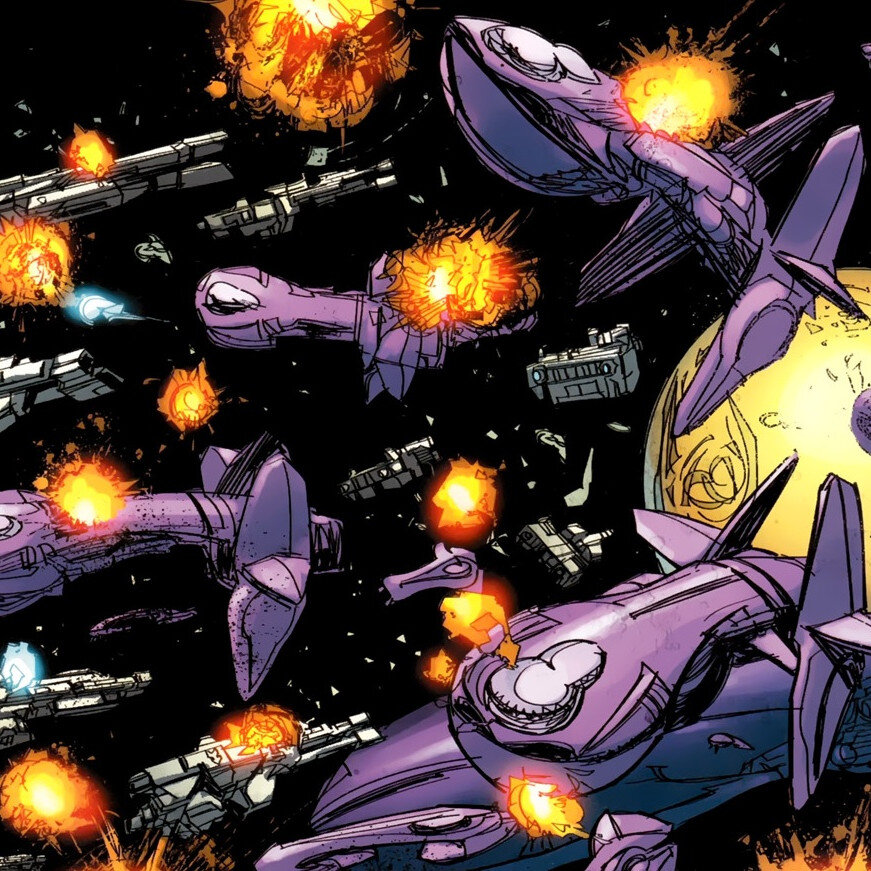
🡀 ENEMIES • CHARACTERS • UNITS 🡂
 Important Events
Important Events
Operation: SILENT STORM was a UNSC operation to use EVA tactics to infiltrate Covenant vessels and either capture or destroy them from within early in the Human-Covenant War in March and April 2526.
The Battle for Arcadia was a battle for the colony Arcadia in the Procyon system, which occurred in the immediate aftermath of the Harvest Campaign.
The Battle of the Etran Harborage was a battle between the UNSC Spirit of Fire and Covenant forces lead by Arbiter Ripa 'Moramee on Shield World 0459, also known as the Etran Harborage.
The Battle of the Rubble was a battle that took place in the 23 Librae system on a grouping of Lagrangian asteroids trailing Hesiod, a gas giant in the system, some time around 2535.
The Battle of Sigma Octanus IV was a large-scale space and ground battle between UNSC and Covenant forces in the Sigma Octanus system in July 2552.
The Fall of Reach was possibly the largest battle during the Human-Covenant War, taking place in the Epsilon Eridani system, in orbit and on the ground of Reach, humanity's largest military stronghold.
The Battle of Installation 04 was an engagement between the UNSC Pillar of Autumn and the Covenant Fleet of Particular Justice on and around the Forerunner megastructure known as Installation 04, or Alpha Halo, in the Soell system.
The Battle for Earth was a large-scale space, air, and ground battle between the invading Covenant forces and the UNSC Home Fleet on and around Earth at the end of 2552.
The Onyx Conflict was a major engagement between UNSC, Covenant, and Forerunner forces on and around the planet of Onyx in the Zeta Doradus system in October and November 2552.
The Battle of Installation 05 was an engagement between the Covenant forces, including those that fled the Battle for Earth, High Charity, and the Second Fleet of Homogeneous Clarity, and the UNSC-allied forces, including the UNSC In Amber Clad led by Miranda Keyes, and the Fleet of Retribution led by the Arbiter Thel 'Vadam.
The Battle of Installation 00 was a major conflict between the forces stationed aboard the UNSC Forward Unto Dawn and Arbiter Thel 'Vadam's Fleet of Retribution, and the Covenant fleet loyal to the Prophet of Truth.
The Spartan-IV program was the third successful Spartan training program and the first since the end of the Human-Covenant War.
The Battle of Requiem was a conflict between former Covenant forces under the command of Jul 'Mdama, UNSC forces from the UNSC Infinity and Forward unto Dawn, and Promethean forces under command of the Ur-Didact on Forerunner Shield World 0001, also known as Requiem, in July 2557.
The Raising of the Guardians was a series of events involving the awakening and unearthing of Forerunner ships known as Guardians by Cortana in late October 2558.
The Battle of Genesis was an engagement between the UNSC, Promethean forces under command of Cortana, and the remains of Jul 'Mdama's Covenant forces on the artificial Forerunner installation known as Genesis in October 2558.
The Second Ark Conflict was a battle between the UNSC forces aboard the Spirit of Fire and the Banished forces under command of Atriox on Installation 00 in 2559.
 Important Events
Important Events
Operation: SILENT STORM was a UNSC operation to use EVA tactics to infiltrate Covenant vessels and either capture or destroy them from within early in the Human-Covenant War in March and April 2526.
The Battle for Arcadia was a battle for the colony Arcadia in the Procyon system, which occurred in the immediate aftermath of the Harvest Campaign.
The Battle of the Etran Harborage was a battle between the UNSC Spirit of Fire and Covenant forces lead by Arbiter Ripa 'Moramee on Shield World 0459, also known as the Etran Harborage.
The Battle of the Rubble was a battle that took place in the 23 Librae system on a grouping of Lagrangian asteroids trailing Hesiod, a gas giant in the system, some time around 2535.
The Battle of Sigma Octanus IV was a large-scale space and ground battle between UNSC and Covenant forces in the Sigma Octanus system in July 2552.
The Fall of Reach was possibly the largest battle during the Human-Covenant War, taking place in the Epsilon Eridani system, in orbit and on the ground of Reach, humanity's largest military stronghold.
The Battle of Installation 04 was an engagement between the UNSC Pillar of Autumn and the Covenant Fleet of Particular Justice on and around the Forerunner megastructure known as Installation 04, or Alpha Halo, in the Soell system.
The Battle for Earth was a large-scale space, air, and ground battle between the invading Covenant forces and the UNSC Home Fleet on and around Earth at the end of 2552.
The Onyx Conflict was a major engagement between UNSC, Covenant, and Forerunner forces on and around the planet of Onyx in the Zeta Doradus system in October and November 2552.
The Battle of Installation 05 was an engagement between the Covenant forces, including those that fled the Battle for Earth, High Charity, and the Second Fleet of Homogeneous Clarity, and the UNSC-allied forces, including the UNSC In Amber Clad led by Miranda Keyes, and the Fleet of Retribution led by the Arbiter Thel 'Vadam.
The Battle of Installation 00 was a major conflict between the forces stationed aboard the UNSC Forward Unto Dawn and Arbiter Thel 'Vadam's Fleet of Retribution, and the Covenant fleet loyal to the Prophet of Truth.
The Spartan-IV program was the third successful Spartan training program and the first since the end of the Human-Covenant War.
The Battle of Requiem was a conflict between former Covenant forces under the command of Jul 'Mdama, UNSC forces from the UNSC Infinity and Forward unto Dawn, and Promethean forces under command of the Ur-Didact on Forerunner Shield World 0001, also known as Requiem, in July 2557.
The Raising of the Guardians was a series of events involving the awakening and unearthing of Forerunner ships known as Guardians by Cortana in late October 2558.
The Battle of Genesis was an engagement between the UNSC, Promethean forces under command of Cortana, and the remains of Jul 'Mdama's Covenant forces on the artificial Forerunner installation known as Genesis in October 2558.
The Second Ark Conflict was a battle between the UNSC forces aboard the Spirit of Fire and the Banished forces under command of Atriox on Installation 00 in 2559.
 Evo-014's Summary
Evo-014's Summary
The origins of the Spartan Program can be traced back to earlier initiatives, namely the ORION Project during the early 24th century and late 25th century. While these initial programs fell short of creating the desired supersoldiers, they made significant scientific advancements.
When the SPARTAN-II Program was established in response to escalating human insurrection during the early 26th century, it marked a triumph, building upon the progress of its predecessors. However, the rigorous process of physical augmentations resulted in approximately half of the candidates surviving the entire program.
Subsequent iterations, such as the Spartan-III Program, further refined the procedures, achieving higher efficiency and lower mortality rates. It wasn't until the conclusion of the Human-Covenant War that the SPARTAN-IV Program emerged, successfully augmenting adults instead of children. This breakthrough allowed for a substantial increase in the number of Spartans created from within the military ranks, effectively resolving the ethical dilemma associated with conscripting child soldiers.
 SPARTAN-II Program
SPARTAN-II Program
In the year 2517, the Spartan-II candidates were forcefully separated from their families at the young age of six. Subsequently, they underwent an intensive eight-year training program on the planet Reach. This rigorous regimen reached its climax with a physically and mentally demanding augmentation process, which sadly resulted in the loss of nearly half of the fourteen-year-old soldiers.
Despite this significant sacrifice, a resilient group of a few dozen Spartan-II soldiers emerged from the trials. These extraordinary individuals would go on to play a pivotal role in humanity's ultimate victory over the formidable Covenant forces.
 SPARTAN-III Program
SPARTAN-III Program
The Spartan-III program was initiated in 2531 and introduced a distinct approach in contrast to its predecessor. Instead of abducting children, the program focused on recruiting orphaned children who had been deeply affected by the ongoing war. While these candidates may not have possessed the same inherent genetic potential as the Spartan-IIs, they underwent the same augmentation procedures with a notably higher success rate.
Approximately 1,000 Spartan-III soldiers were forged, yet regrettably, the majority of them met their fate in daring suicide missions during 2537 and 2545. Despite their sacrifices, the Spartan-III warriors exhibited extraordinary bravery and unwavering dedication in the face of overwhelmingly unfavorable circumstances.
 SPARTAN-IV Program
SPARTAN-IV Program
In the wake of the Human-Covenant War, the Spartan-IV program was launched, marking a notable departure from previous recruitment practices. Instead of enlisting child candidates, the program focused on augmenting adult members of the military. While these candidates did not undergo the same arduous training as the Spartan-II or Spartan-III soldiers, they still embodied the pinnacle of combat expertise within the UNSC.
As the Covenant fragmented into various hostile factions, the Spartan-IVs assumed a pivotal role in preserving order across the galaxy. Deployed extensively, they served as elite soldiers entrusted with the responsibility of maintaining peace and security throughout the vast expanse of the cosmos.










































